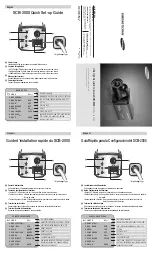
Network camera
Configuration | en
73
Sony Corporation
User manual
2019-07 | V01 | DOC
Click
Set
to apply the changes.
4.3.7
Encoder Profile
Profiles are rather complex and include a number of parameters that interact with one
another, so it is generally best to use the pre-defined profiles. Only change a profile if
completely familiar with all the configuration options.
Changing a profile
To change a profile, select it by clicking its tab and then change the parameters within that
profile.
If a setting outside the permitted range for a parameter is entered, the nearest valid value is
substituted when the settings are saved.
Profile name
If required, enter a new name for the profile.
Bit rate optimization
Select the necessary bit rate optimization setting.
Maximum bit rate
The encoder maintains the maximum bit rate over a number of GOPs (group-of-pictures),
limiting image quality when necessary. To ensure long-term stability of the maximum bit rate,
use the
Averaging period
.
The value entered in this field must be at least 10% higher than the value entered in the field
Target bit rate
. If the value entered here is too low, it will be adjusted automatically.
The value in this field is not to be interpreted as the network transmission bit rate.
Averaging period
Select the appropriate averaging period as a means of stabilizing the long term bit rate.
Target bit rate
To optimize use of the bandwidth in the network, limit the data rate for the device. The target
data rate should be set according to the desired picture quality for typical scenes with no
excessive motion.
For complex images or frequent changes of image content due to frequent movements, this
limit can temporarily be exceeded up to the value entered in the
Maximum bit rate
field.
Encoding interval
The
Encoding interval
slider determines the interval at which images are encoded and
transmitted. This can be particularly advantageous with low bandwidths. The image rate is
displayed next to the slider.
Expert Settings
If necessary, use the expert settings to adapt the I-frame quality and the P-frame quality to
specific requirements. The setting is based on the H.264 quantization parameter (QP).
I-frame distance
Use the slider to set the distance between I-frames to
Auto
or to between
3
and
255
. An entry
of 3 means that every third image is an I-frame. The lower the number, the more I-frames are
generated.
Min. P-frame QP
In the H.264-protocol, the Quantization Parameter (QP) specifies the degree of compression
and thus the image quality for every frame. The lower the QP value, the higher the encoding
quality. A higher quality produces a higher data load. Typical QP values are between 18 and
30. Define the lower limit for the quantization of the P-frames here, and thus the maximum
achievable quality of the P-frames.
Summary of Contents for SNC-EMX30
Page 274: ......
Page 275: ... Bosch Security Systems B V 2019 2019 07 V01 ...
















































